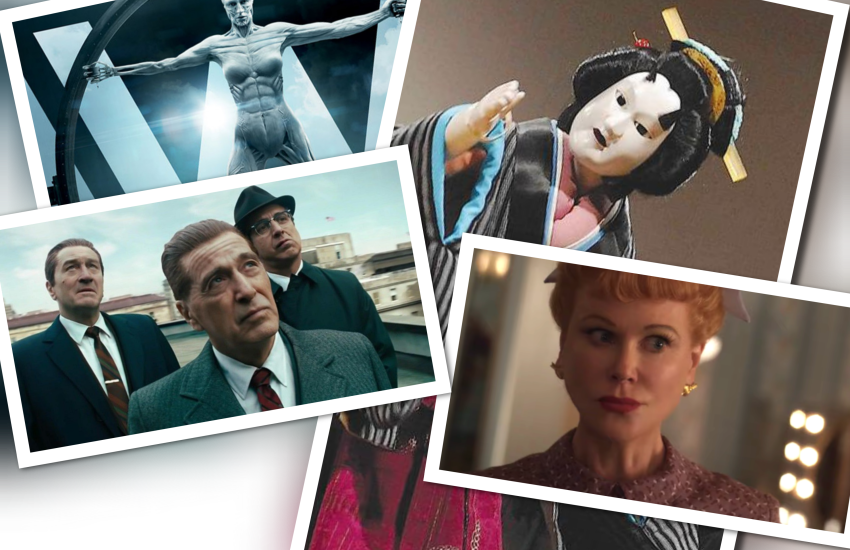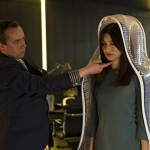Last weekend I watched The Irishman, (2019), Martin Scorsese’s film about hit man Frank Sheeran looking back at his life and the secrets he kept as a loyal member of the Bufalino crime family. I resisted watching it for a couple of years as I felt the same way, allegedly, that Jo Pesci, who plays Russell Bufalino in the film, did: Gah, not another gangster movie.
However, in the face of the usual Netflix overchoice, a term used by Alvin Toffler in his book Future Shock (1970), along with information overload, which predicted our daily digital life of too much choice, and my fear of my pizza getting cold, I caved and we went for The Irishman.
Three and a half hours later, as the final credits rolled I looked up to see that everyone had gone to bed, and I couldn’t talk about this great film, until everyone else had seen it the following night, so I googled all the reviews to see what the consensus was and to find out exactly how they had made Al Pacino, Robert De Niro and Jo Pesci young again, in a way one reviewer thought landed them in the uncanny valley. Don’t worry I will write this without spoilers.
The uncanny valley was first defined in 1970 in an essay by robotics professor Masahiro Mori to describe the gap between humans and robots and how the more designers improve robot aesthetics to replicate humans, i.e., make them lifelike, the greater the risk that the resulting likeness will be freaky and eerie as it falls into in a no-man’s land between human and robot of things real and fictional, from traditional Japanese Buranku puppet theatre to those things which freak us out such as dolls who come to life in films and Madame Tussaud‘s waxwork figures.
Ghosts and valleys
In the same way in which popular culture has adopted the ghost in the machine, which I blogged about in The Ghosts of AI, (2018), the term the uncanny valley describes a whole range of the unsettling – from animated films that don’t work, to actors being digitally altered to serve the plot twist such as Will Smith’s clone in Gemini Man, to The Atlantic in 2012 using the term to discuss US presidential contender Mitt Romney.
Interestingly enough, when Hilary Mantel called HRH future queen Kate Middleton, a plastic princess in 2013, there was the usual British media outcry. Even I blogged about Mantel’s lecture in Women’s bodies: Society, Storytelling, Technology (2), (2017) , saying that it was unkind. I felt that Mantel was implying that Kate has no say in how she shows up in the world and that it distracted the reader during what was overall a compelling essay about the Royal family throughout history being public property. Today though, I wonder, would I have felt better about her comments had she cited robotics theory? Or would I have remained as distracted as I was watching the various ages of Robert de Niro? That said, it didn’t repulse me and it didn’t feel eerie, it was compelling.
Blue eyes and Hooo haaas
The film began with Robert de Niro as a very old man, and then the first flashback was to him as a younger man with dazzling blue eyes. This was very distracting and for the longest while I couldn’t put my finger on it until I realised that he has brown eyes and they must have been contact lenses. One reviewer made me laugh when they said that the blue eyes made him look like John Wayne. After that when we got going into the flashbacks to more innocent days, the younger de Niro and Pesci, seemed a bit sepia toned, which to me was fitting and not distracting at all. When the film then moved on a decade or some years, who knows really? It was when Al Pacino is in many scenes, brilliantly cast in his role as Jimmy Hoffa, so he could do his hoo-haaing and hamming it up as only he can do. Then, there was one scene when he is sitting on a bed in his pyjamas going on at great length, as his character did, that I said to my hubby: What is going on with his face? It looks all mottled. To me it wasn’t eerie, but it was strangely lit, on top of which he had a peculiar hairdo, which must have been a big hairpiece sitting on top of his head, looking to be honest, a bit like Lego hair.
Pacino’s hair reminded me of Robbie Savage’s hair during Euro 2020 – though on telly last summer 2021 because of COVID-19. It had a life of it’s own, and oh dear now I’ve got started Alan Hanson’s eyebrows on Match of the day when he sat there every week and said: You have to score goals to win, which is why he got paid the big bucks. Anyway, back to Al Pacino on the bed hooo-haaing with a mottled face.
A who’s who of mob movies
The story goes, apparently, that it took years to get funding to shoot The Irishman and so these three amazing actors, actually there are loads more in there including Anna Paquin and Harvey Keitel, and the who’s who of all the mob movies: Ray Romano, Bobby Cannavale, Steve Van Zandt, et al, it was great to spot them. However, by the time, things were in place to start shooting, de Niro, Pacino, and Pesci were already in the 70s with over 150 years of acting experience between them. One of de Niro’s eyebrows can speak volumes, so Scorsese didn’t want to cover that up with the usual mask and markers (or to use the correct terminology: a mo-cap stage, headgear and face-tracking dots) needed to superimpose a younger face on an older actor using matrix manipulation in postproduction so that the young face is overlaid on the old face.
Instead, they invented a new form of technology which used their faces but with a mixture of lighting, prosthetics, and two extra cameras on the side of the main camera which captured all the volumetric data or matrix data, needed to superimpose young skin on old skin, whilst maintaining all of the facial expressions. It’s a bit like when filming a football match, we have the real film and then the virtual reality is rendered to calculate all the views not caught on camera which I blogged about back in 2008 (and which got a lot of hits during the Euros) so that the football and players can be seen from all angles to decide whether someone is offside or not. Wired magazine does a great explanation of the Flux technology they invented for The Irishman in order to process all the data and clean up everyone’s faces throughout post processing and Netflix have a great movie on YouTube about it.
Ageing and de-ageing in movies, and women in real life
Some reviewers said that they could tell that the actors moved like they were in their 70s, in a way they hadn’t say in Goodfellas (1990) even though in 1990 de Niro was 46 years-old but starts off playing his 29 year-old self and we believe it because he is still young and full of energy. It was a male reviewer who wrote this, so for the sake of good research and also because it is a fantastic film, I went and rewatched Goodfellas the other night. I don’t think that de Niro looks 29 years old, he looks older, a bit like how in teen movies the actors are always nearer 30 years old, like Dirty Dancing. So, I wasn’t bothered by de Niro seeming older, it didn’t jar, the rigidity and posturing went with him being a tough guy – and reminded me of Silvio Dante in The Sopranos, played by Steve Van Zandt (who also made a guest appearance singing in The Irishman, I was like to my long suffering husband: Who is that? He’s familiar.).
However, for me, a woman, and I said it this week when I was sitting with a group of men of various ages whilst on a plastering course (blog to come about that), it’s hard to tell a man’s age. Most men could be any age from 21 years old to 50 years old, they are hard to place because they are rarely defined by their age. In contrast to women, who have to always seem fertile and young and sexy, as they have been our roles in life, and this was what struck me about The Irishman. It was a film by men for men. The women were there for decoration only or to move the plot on in tiny support roles, and they didn’t seem to age at all, or perhaps they were far younger to begin with, and seemed incredibly well preserved even when the men were way, way older. And, this leads me to my final point which I was hesitant to discuss because of solidarity of the sisterhood and what have you, but here goes:
I was glued to The Irishman, and wasn’t distracted by the way the men aged and de-aged, I thought it was well done and they are great actors. However, the week before, I tried to watch Being the Ricardos on Prime and I just couldn’t. I was so distracted by Nicole Kidman and how she doesn’t have a single line on her face in contrast to everyone else who shared screentime with her such as Javier Bardem and Alia Shawkat, who is at least 20 years younger than Kidman. Kidman’s lack of expression and smooth shiny complexion was so distracting, that even though she too is a great actress, it pitched me right into the uncanny valley, to point that I couldn’t focus on anything else. Perhaps it was subtle lighting and make-up, as described in Variety Magazine? Or perhaps she was digitally de-aged too? I don’t know. All I know is that her face seemed mask-like, Buranku style (I am so sorry, Nicole) and given that her facial changes have been speculated about and well documented over the years, it unsettled me to such a degree that I had to turn the television off because I was too busy looking at her face and not seeing her as Lucille Ball.
Perhaps our perceptions of actors are gender specific as like the male reviewer who looked at de Niro and found himself in the uncanny valley, in a way I did not would not have had the same response I did to Kidman. Who knows?
Speculation aside, I loved The Irishman and Goodfellas. I loved the entertainment and the whole trip into the technology I took when writing this blog. As I’ve said before in other contexts, we seem to spend a lot of time turning our humans into robots and our robots into humans to satisfy the many stories which run our society and on a bad day, resembles more and more the freaky, uncanny valley we are all hoping to avoid.






